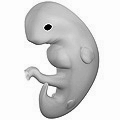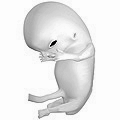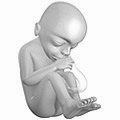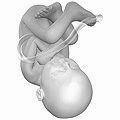Pregnancy

Pregnancy is when a female mammal has an unborn baby inside her. During pregnancy, a female is called "pregnant". A human pregnancy is about 38 weeks long, from conception to childbirth. Usually the mother has one baby at a time. Sometimes the mother has two babies at one time. Two babies are called twins. The mother can have three or more babies at one time. This does not happen very often in humans.[1]
Start
Some people have trouble becoming pregnant. This is called infertility. Women and men with infertility may take drugs or have surgery to help a pregnancy start. Some people use treatments that are not natural, like in vitro fertilization, to become pregnant with the help of a doctor.
Growth of the baby
When the woman's egg and the man's seed come together, it makes one cell called a zygote. The zygote grows into an embryo, which grows into a fetus. When the fetus is ready, the baby is born.
Embryo at 4 weeks after fertilization[2]
Fetus at 8 weeks after fertilization[3]
Fetus at 18 weeks after fertilization[4]
Fetus at 38 weeks after fertilization[5]
Length
Human pregnancy is divided into three parts called trimesters. A trimester is about three months long. During the first trimester, the woman might feel ill in her stomach. She might have to urinate often. During the second trimester, the woman's abdomen starts to stick out. During the third trimester, her abdomen sticks out even more, and she becomes even heavier.
Birth
At the end of a full pregnancy, the woman's body pushes the baby out. This is called delivering a baby or giving birth. Mothers can get help for birth from a midwife, nurse, or doctor. In some places, mothers give birth at home. In other places, mothers give birth in a hospital. Mothers who are ill or hurt may need to go to a hospital.
Giving birth can hurt a lot at the end. In hospitals, a doctor or midwife can give drugs to the mother to reduce the pain.
If the baby cannot be pushed out, then a doctor can cut the mother open to take the baby out. This operation is called a Caesarean section.
Social problems
The Convention on the Elimination of All Forms of Discrimination against Women says that pregnant women must be given time away from work or equal welfare for her baby without losing her job (Article 11).
Pregnancy problems
Sometimes there are problems with pregnancies. A miscarriage (spontaneous abortion) is when the baby dies before it is born. A stillbirth is when the baby is dead when it is born. There are also diseases caused by pregnancy.
Sometimes, women die from giving birth. In developed countries, this is much less common than it used to be. Every year, about 500,000 women die from giving birth, while about 7,000,000 mothers have big problems from giving birth.[6] For example, giving birth can tear the mother's body and cause an obstetric fistula.
Abortion
A pregnancy can also stop without the baby being born. This is called abortion. Doctors can do things that will stop a pregnancy. Such an abortion is called induced abortion. Countries have different laws about induced abortions. Some countries allow it, and others do not. In some countries, it is allowed, but only for certain reasons, such as the pregnancy resulting from rape, or a doctor saying that the pregnant woman might die if the pregnancy is not stopped. People also have different opinions about abortion. Often, these are influenced by religious beliefs.
There are a few diseases that can kill a woman or make her very ill if she has a baby. Having abortions could save the lives or health of these mothers.
Pregnancy test
A pregnancy test is something that women use to tell whether they are pregnant. The woman urinates on the stick. If the woman is pregnant, a plus sign or two lines will appear on the stick.[7] If the woman is not pregnant, then a minus sign or one line will appear on the stick.
Notes
| Wikimedia Commons has media related to Lua error in Module:Commons_link at line 62: attempt to index field 'wikibase' (a nil value).. |
- ↑ Baldwin, Virginia J. (1994). Pathology of Multiple Pregnancy. Springer Science & Business Media. p. 349. ISBN 978-0-387-94011-3.
- ↑ 3D Pregnancy (Image from gestational age of 6 weeks). Retrieved 2007-08-28. A rotatable 3D version of this photo is available here, and a sketch is available here.
- ↑ 3D Pregnancy (Image from gestational age of 10 weeks). Retrieved 2007-08-28. A rotatable 3D version of this photo is available here, and a sketch is available here.
- ↑ 3D Pregnancy (Image from gestational age of 20 weeks). Retrieved 2007-08-28. A rotatable 3D version of this photo is available here, and a sketch is available here.
- ↑ 3D Pregnancy (Image from gestational age of 40 weeks). Retrieved 2007-08-28. A rotatable 3D version of this photo is available here, and a sketch is available here.
- ↑ Education material for teachers of midwifery : midwifery education modules (PDF) (2nd ed.). Geneva [Switzerland]: World Health Organisation. 2008. p. 3. ISBN 978-92-4-154666-9.
- ↑ "Home Pregnancy Test Kits". IMG Health Publications. Retrieved 29 April 2015.









